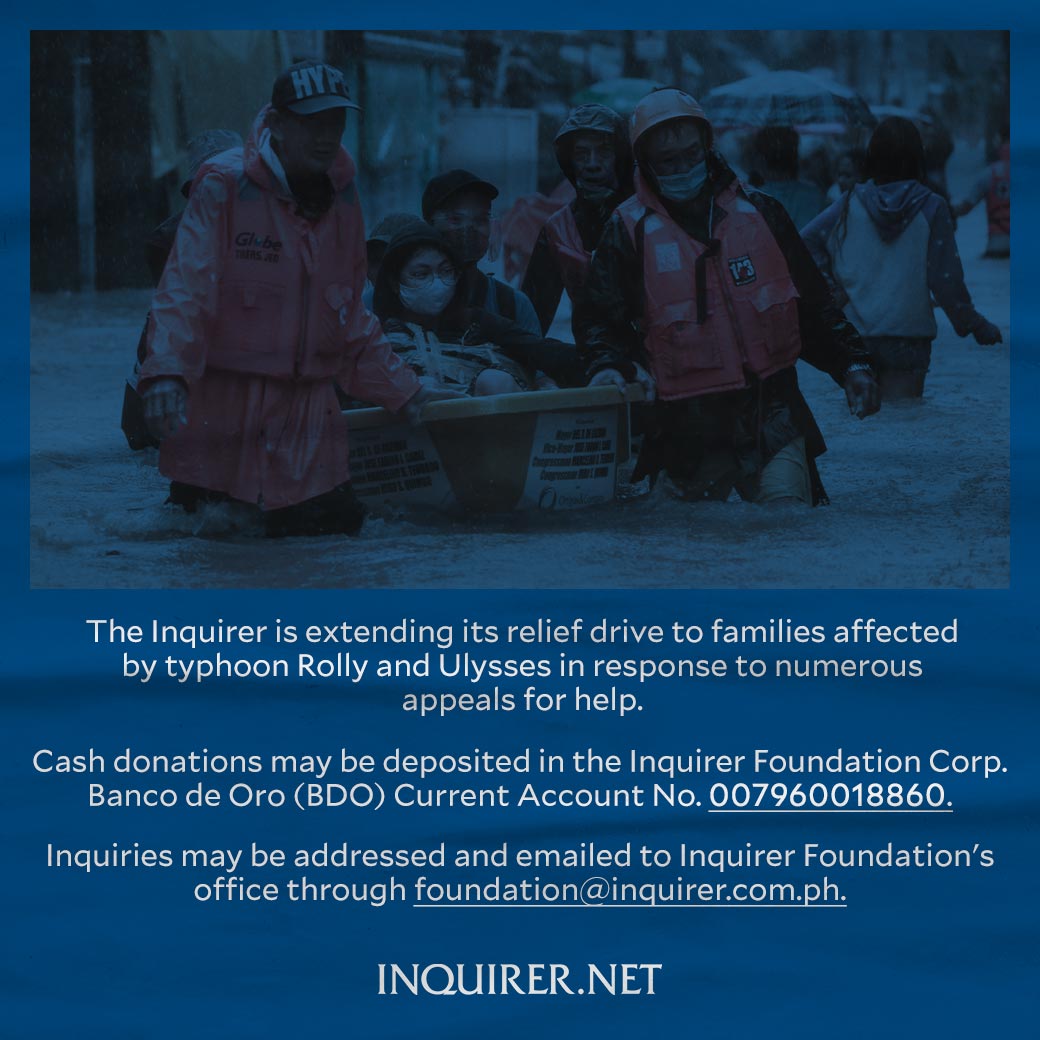Typhoon Ulysses leaves 3 dead; 200K flee Luzon floods

MEMORIES RETURN Members of a family trapped by floodwaters on the second floor of their home at the riverside village of Tumana in Marikina City hand over children to a rescue team that will take them to an emergency shelter. Marikina Mayor Marcelino Teodoro says the floods brought back memories of Tropical Storm “Ondoy” to residents in the city. —RICHARD A. REYES
Typhoon Ulysses (international name: Vamco) swept across Luzon with heavy rain and howling winds until Thursday, causing massive flooding in communities and forcing the evacuation of nearly 200,000 people, officials said. At least three fatalities were reported in Camarines Norte and Rizal provinces.
Defense Secretary Delfin Lorenzana, who chairs the National Disaster Risk Reduction and Management Council (NDRRMC), said the damage brought by Ulysses was “huge.”
“[There are] totally flooded villages in low-lying areas,” he said.
Malacañang announced Friday’s suspension of work in government offices and classes in public schools at all levels in Metro Manila and the Ilocos, Cagayan Valley, Cordillera, Central Luzon, Calabarzon, Mimaropa and Bicol regions.
But all agencies whose functions involve the delivery of basic and health services, preparedness or response to disasters and calamities, and the performance of other vital services will continue operations and render services, presidential spokesperson Harry Roque said in a statement on Thursday.
Article continues after this advertisementWeather forecasters said Ulysses slightly weakened over the West Philippine Sea. At 4 p.m. on Thursday, its center was located 200 kilometers west of Iba, Zambales province, packing winds of 120 km per hour and gusts of 150 kph.
Article continues after this advertisementIt will continue to move westward and may exit Philippine territory by Friday morning, they said.
Quezon landfalls
Close to 400 rescue teams fanned out in different regions to help local governments respond to calls for help from residents stranded in their homes due to rising floodwater.
The NDRRMC said some 53,700 families, or more than 196,000 individuals, were moved out of their houses in many provinces before Ulysses made landfall three times in Quezon province on Wednesday afternoon.
A report from the Office of Civil Defense (OCD) in Bicol listed two fatalities—one in Daet town and another in Talisay town, both in Camarines Norte. In Cainta, Rizal province, a 15-year-old boy identified as Robert Napeñas Jr. died from injuries after a tree fell on his family’s house in a subdivision. (See story in Regions, Page A8.)
The OCD Bicol also reported eight people injured and 188,987 others displaced from their homes.
In a 3 p.m. briefing on Thursday, NDRRMC spokesperson Mark Timbal said 383 search-and-rescue teams had been deployed in the provinces. Each team has five to eight members, he said.
“They have been deployed in Regions 2 (Cagayan Valley) and 3 (Central Luzon), Calabarzon, Mimaropa, Region 5 (Bicol), the Cordilleras and Metro Manila,” Timbal said.
Priority rescue areas
Priority areas, he said, included Rodriguez and San Mateo towns in Rizal, and the cities of Marikina and Pasig.
Timbal said 45 of the teams were from the Armed Forces of the Philippines, 43 from the Bureau of Fire Protection, 250 from the Philippine National Police, 20 from the Coast Guard, and five from the Joint Task Force-NCR (National Capital Region).
He said 282 standby teams were ready to take over the work of those already fielded.
The NDRRMC will continue to respond to calls for rescue, but it will not take over from local governments, Timbal said.
Amid numerous calls for rescue from people stranded in areas hit hard by Ulysses, the council insisted that it was not caught flatfooted in its disaster response.
In an earlier media briefing, OCD Deputy Administrator Casiano Monilla said the NDRRMC “cannot micromanage” and that local governments were in the best position to respond to natural calamities.
Monilla said the agency had given adequate reminders to the local governments for the past two days, resulting in several preventive measures before heavy rain came. All necessary warnings and notifications of storm hazards were sent directly to the public through the NDRRMC alerts, he said.
‘Ondoy lessons’
He said the council had learned many lessons from the devastation brought by Tropical Storm “Ondoy” in 2009 and had two predisaster risk assessment meetings for Ulysses. (See related stories on Page A4.)
Pressed on why there were still many reports of people stranded and needing rescue despite the supposed preparedness of the NDRRMC, Monilla said one reason was that residents in flood-prone areas sometimes did not heed warnings.
“It’s the reaction of most, they go with what they feel at the given time [even when there are warnings.] When Pagasa (Philippine Atmospheric, Geophysical and Astronomical Services Administration) says it is signal No. 3, it means it is coming, not necessarily that it is happening already,” he said.
“The national agencies cannot micromanage, we have the local government[s] to respond,” Monilla said.
Timbal said the NDRRMC still had adequate funds to respond to the needs of displaced families.
“Right now, we are using the quick response funds of different agencies involved, since we have access to these funds,” he said. The Department of Social Welfare and Development has its own standby funds and stockpiles, Timbal said. —WITH REPORTS FROM JEROME ANING AND JHESSET O. ENANO
